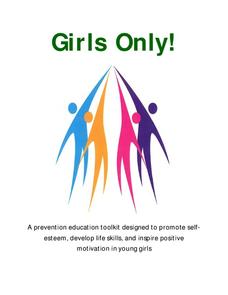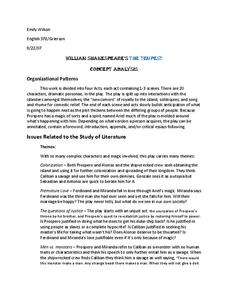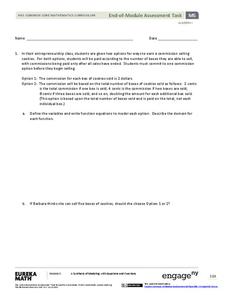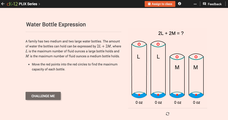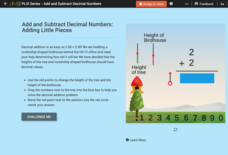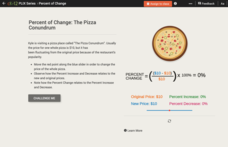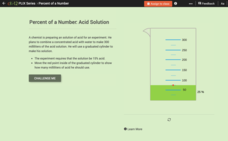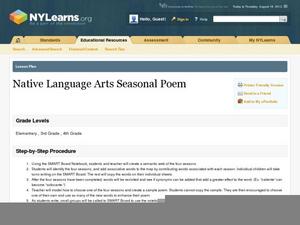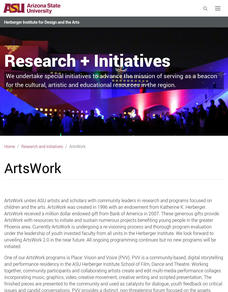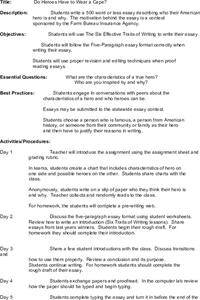San Diego County District Attorney
Girls Only!
Promote positive self-esteem in young girls with this educational toolkit—a thorough document that lists a wide variety of activities, from writing an I am poem or learning to give compliments to a conflict resolution role-play...
Novelinks
The Tempest: Concept Analysis
Use a handy concept analysis guide as you begin your unit on William Shakespeare's The Tempest. With character descriptions, literary themes, and anticipated affective issues, the guide can help those new to using The Tempest craft...
Houghton Mifflin Harcourt
Special Friends: English Language Development Lessons (Theme 9)
Enhance language proficiency with a Special Friends themed English language development unit. Each lesson follows a listen, speak, move, and/or look routine that is guaranteed to get your scholars discussing topics such as animal...
Curated OER
Out of the Dust: Biopoem
As part of their study of Out of the Dust, readers create a biopoem for one of the characters in Karen Hesse's 1998 Newbery Medal winning verse novel.
EngageNY
End-of-Module Assessment Task - Algebra 1 (Module 5)
This unit assessment covers the modeling process with linear, quadratic, exponential, and absolute value functions. The modeling is represented as verbal descriptions, tables, graphs, and algebraic expressions.
CK-12 Foundation
Coriolis Effect: Flying... South?
It turns out there's a lot more to heading south for the winter for migratory birds! Study the Coriolis Effect with a fun, hands-on teaching tool. Pupils take to the skies as a small red bird bound for the tropics from his frosty home at...
CK-12 Foundation
Slope-Intercept Form of Linear Equations: Cable Car Tracks
Get on track to learn about slope-intercept form. Scholars use an interactive to position a line along the tracks of cable car. Applying knowledge of slope and intercepts, they write the slope-intercept form of the equation for the line.
CK-12 Foundation
Evaluate Expressions with One or More Variables: Water Bottle Expression
Fill your mind as you fill virtual water bottles. Pupils use an interactive to find the amount of water that can fit in given containers. Writing and evaluating an algebraic expression helps with this task.
Education World
Public Speaking Lesson: The Impact of Bullying
It's one thing to prevent yourself from becoming a bully, but how do you convince others to follow suit? Take the first step in creating a better world with a public speaking lesson that prompts learners to write and present persuasive...
CK-12 Foundation
Logarithm Properties: The Log Properties
Roll a log into an equivalent expression. Given four expanded logarithmic expressions, pupils write an equivalent condensed expression. They identify which properties allows for the simplification.
University of Pennsylvania
Using Comic Strips to Teach Multiple Perspectives
Scholars view comics from two different perspectives; one paints the Alfred Dreyfus as innocent, while the other portrays the exact opposite. They solve the mystery of what happened by analyzing the source, working in groups, and...
CK-12 Foundation
Decimal Addition: Adding Little Pieces
A five-question interactive test scholars' knowledge of adding and subtracting decimals. A tool aids in problem-solving with movable parts that reveal addends and sums. Question types include one discussion, fill and in the blank, and...
CK-12 Foundation
Percent of Change: The Pizza Conundrum
Nine questions—multiple choice and fill in the blank—challenge mathematicians to solve money word problems. Looking closely at prices, scholars use a formula to identify percent increases and decreases based on an original and new price....
CK-12 Foundation
Percent of a Number: Acid Solution
Mathematicians answer five questions about percents, ratios, and proportions with help from an interactive graduated cylinder. Question types include multiple-choice, fill-in-the-blank, and discussion.
CK-12 Foundation
Values Written as Powers: Binary Numbers 9 to 16
Challenge mathematicians to crack the binary code with an interactive that focuses on numbers nine to 16. A table reveals exponential equations to aid in answering multiple-choice questions. A discussion question gauges comprehension.
Curated OER
Native Language Arts Seasonal Poem
Intended for native Spanish speakers, this plan provides an opportunity to create a class semantic web describing the different seasons and listen to Vivaldi's "Four Seasons." Learners will work together to revise their semantic webs,...
Curated OER
Image to Word
Students research art and write about how a certain art piece relates to their own life. In this art lesson plan, students go to Brooks museum and discuss the art they find there.
Curated OER
Electricity and Magnetism
Make oral presentations electric and magnetic! As the conclusion of the study of electricity and magnetism, class members are assigned to bring to life items or people associated with these topics. Speaking as the person or object,...
Curated OER
Will the Leaning Tower Fall?
Young scholars research the Tower of Pisa and write a report about its history. They examine the physics of why it leans and whether it might fall. Students plan a trip to Italy to view the Tower. They develop an itinerary and budget for...
Curated OER
Formatting Fun
Launch this lesson plan by saving the provided Formatting Fun template on your classroom or library computers. Young learners can then practice formatting basics for use in writing activities. Exercises include practice in highlighting...
Curated OER
Through Many Lenses: How are Countries Depicted by the Media?
If you plan to utilize the ABC miniseries, "The Path to 9/11" in your classroom, consider incorporating media literacy and research skills. After (or while) learners view the series, they discuss ways information can differ from source...
Curated OER
Creating Plays from Children's Stories
Pupils explain how individual elements (e.g., plot, theme, character, conflict, etc.) comprise the structure of a play. They write an original one-act play with developed characters, specific setting, conflict, and resolution.
Curated OER
Indian Story Bag
Students use an object to tell an interesting story from their lives. They write and present a short story about an interesting episode from their life and gather objects in a story bag, which illustrates their story to the class.
Curated OER
Do Heroes Have to Wear a Cape?
Young writers choose a person from American history, their community, or their family to use as the subject of a persuasive essay. The process begins with a discussion of the characteristics of a hero, the completion of a prewriting web,...


